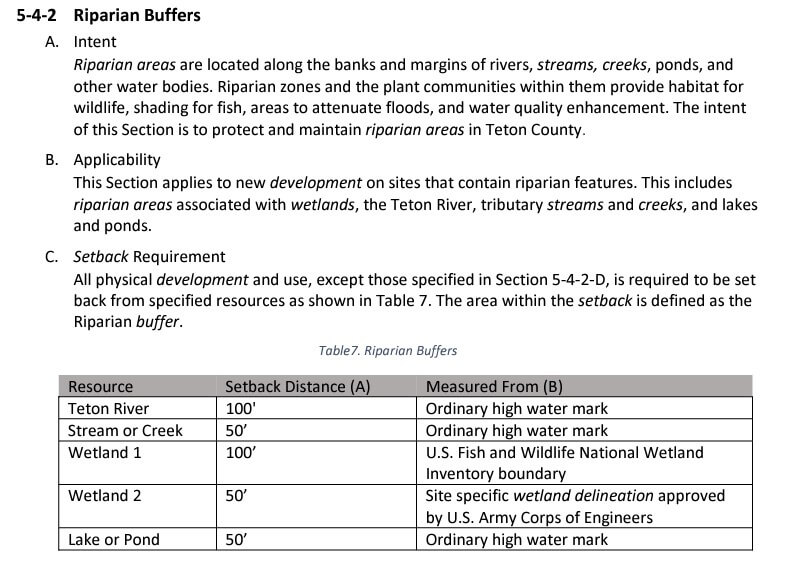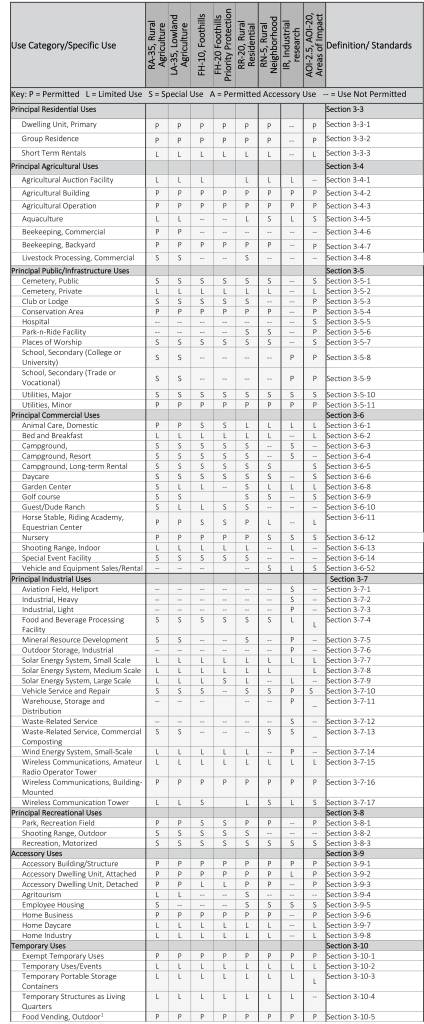As a reminder, this is the third part in a multi-part blog article describing Teton Valley’s new zoning map and land use code. Always refer to the actual and most recent revision of the code, and keep in mind that this is for the unincorporated areas of Teton County and does not include the city limits of Driggs, Victor, or Tetonia. This does not include Alta Wyoming, refer to Teton County, Wyoming for land use regulations there. This article does not account for subdivision covenants, conditions and restrictions, which would be an additional layer above the county regulations. In the event that the county regulations provide for a use, setback or otherwise, you can generally expect that the county restrictions will supersede those outlined in any subdivision documents.
RESIDENTIAL ZONE USES
As described in the first two parts of this article, there are essentially two types of zones with varying density requirements. While it’s a bit more complex, there is essentially an agricultural/residential zone and an industrial zone. You can find an overview of the zone types in Part I, here.
What can I build?
Agriculture or residential zones (which account for almost all zones aside from the industrial zone) allow for a primary dwelling unit or a single-family home. Keeping in mind any subdivision restrictions, they would also allow for an agricultural building or operation, and an attached accessory unit. We will go into that in a little more detail, below.
*Height limitation: 30 ft
*Agricultural Building height limitation: 60 ft
***Maximum Height Limitations vary with development located within 500′ of right-of-ways along Ski Hill Road, State HWY 31, 32 & 33.
*Setbacks: Refer to Part II, here for each zone. In addition, any physical development near the Teton River must be setback 100’ from the ordinary high water mark, and 50’ from any other stream, creek or pond, see below tables:


*Ridgeline Construction: Physical development shall not breach ridgelines as viewed from State highways. If this is unavoidable, a “visual resource analysis” is required.
*** Other factors can impact setbacks (including but not limited to), development and building allowances, including irregular shaped lots, roads, site features, utilities and overlays such as wildlife and fire overlays.
Accessory Buildings (sheds, etc)
Accessory buildings such as a tool shed or storage shed are allowed in all county zones. They must adhere to the dimensional standards required by each zone district, primarily height and setback requirements.
Building Permits
Building permits are required for any structure over 200 SqFt unless it is a dwelling, in which case a permit will be required for any size.
Manufactured & Modular Homes
Manufactured homes, except those built prior to 1976 are allowed as long as they are constructed to satisfy the uniform building code (UBC). Modular homes are also subject to the building codes.
Guest Houses
Also known as accessory dwelling units, these standards vary based on the zoning type. ONE guest house is allowed per parcel where appropriate parking and wastewater treatment provisions are installed, with maximum square footage requirements as follows;
*Attached Guest Houses: must not exceed 1500 SqFt.
*Detached Guest Houses:
Parcel Size | Maximum Sq Ft
7.5 acres+ | 1500 SqFt
2.5 – 7.5 acres | 1200 SqFt
<2.5 acre | 900 SqFt
Short-Term Rentals
Short-term rentals are loosely defined as lodging for terms of 30 consecutive days or less. We’ve talked about Idaho’s legislature in past articles, so it is difficult for any municipality or land use code to restrict short term rentals. However, there are some limitations on use. It’s important to also keep in mind that homeowners associations can restrict short-term rentals, but most do not. Aside from some basic guidelines that would seem obvious, here are some highlights:
1) You must obtain a short-term rental business permit (which does carry a fee), and it must be determined that the wastewater treatment system is sufficient for the size of home.
2) There are county-wide quiet hours from 8:00 p.m. to 8:00 a.m.
3) Special events (weddings are a good example) with guests beyond those allowed on the property must obtain a temporary use permit.
4) Smoke detectors, carbon monoxide detectors and fire extinguishers must be installed.
5) All Property owners within 200 ft of the short-term rental property shall send written notice, including contact information.
6) The address and access directions must be posted on the inside front door.
Bed and Breakfast
A bed and breakfast can be allowed on a limited use basis for up to three units. 4 to 8 units may be allowed with a special use permit approved by the Planning and Zoning Commission and Board of County Commissioners. In addition to the short-term rental regulations, the B&B must maintain the residential character of the neighborhood with no business-related storage warehouses or supplies allowed outside. One sign is allowed that is no larger than 3 SqFt, there must be central dining facilities and any food service must be reviewed and approved by the Teton County Fire Marshall. In addition, a food license or proven exemption must be obtained from East Idaho Public Health.
Campgrounds
Campgrounds are considered with a special use permit in all zones except for the RN-5 Rural Neighborhood zone and the areas of impact. In addition, here are some basic requirements that must be met before a proposal will be considered by the Planning and Zoning Commission and Board of County Commissioners:
Minimum Lot Size | Maximum Camp Sites
40 acres | 20 campsites
60 acres | 30 campsites
80 acres | 40 campsites
100 acres | 20 campsites
40 acres | 50 campsites
120 acres | 60 campsites
Additional guidelines include:
1) 80% of the sites must remain as undeveloped open space Parks or recreational amenities.
2) tent sites must include a level pad at least 150 SqFt and parking at least 200 ft in size. RV sites must be at least 1,350 SqFt to accommodate an RV and parking in addition to hook ups that meet state and local requirements.
3) 200 ft property setbacks.
4) Wastewater systems must be approved by East Idaho public health.
5) All interior roads must meet Teton County fire department requirements.
6) Screening on property sides.
7) Stays shall be limited to 14 consecutive days (or less).
Note that there is also a long-term rental campground with similar restrictions and a minimum stay of 31 consecutive days. It’s important to keep in mind that the same property cannot offer both long-term and short-term camping.
Glamping (Resort Style Campgrounds)
Similar to campgrounds, resort style campgrounds can be allowed with a special use permit in all zones (again, this will require Planning and Zoning and Board of County Commissioners approval) with the exception of the RN-5 Rural Neighborhood zone and the areas of impact.
The regulations for resort campgrounds (aka glamping with tipi’s, yurts, cabins or tiny homes) you have similar restrictions to campgrounds with these highlights:
1) “Units” to be 500 ft or smaller.
2) Minimum lot size to be 40 acres.
3) A maximum of 10 units or less.
4) All facilities, platforms, structures and wastewater treatment shall be provided and comply with state and local building code requirements and East Idaho Public Health requirements.
Daycares
Daycares are allowed in all zones except the industrial zones with a special use permit which again requires Planning & Zoning and Board of County Commissioners approval. They do have obvious regulations for health and safety. Home daycares are allowed on a limited use basis which would not require the aforementioned approvals, but do have some regulation.
INDUSTRIAL/RESEARCH ZONE USES
The industrial zone is suitable for business oriented uses with uses such as outdoor storage, vehicle service and repair, distribution, warehouse and other similar uses permitted, and a variety of other uses (usually not otherwise permitted) allowed on a limited or special use basis.
Dwellings
While standalone dwellings are not permitted in the industrial zones, attached accessory dwelling units are allowed with limitations, and short-term rentals are not allowed.
USE TABLE SUMMARY
Below is a “Use Table” with various categories and specified uses. You can refer to the zoning map overview in Part I, here.
The use table establishes allowed uses by zone district. No building or lot may be used except for
a purpose allowed in the district in which it is located.
3-2-1 Use Table Key
A. Permitted Use (P)
Indicates a use that is allowed or permitted by right in the respective district. The use is also
subject to all other applicable requirements of the LDC.
B. Limited Use (L)
Indicates a use that is allowed in the respective district, by Planning Administrator approval per
Section 4-1-3 herein, subject to specific use and dimensional standards. The locations of the
relevant use standards are found in the definitions in Sections 3-3 to 3-8-10. The use is also
subject to all other applicable requirements of the LDC.
C. Special Use (S)
Indicates a use that may be allowed in the respective district only after recommendation by the
PZC and approval by the BoCC as set forth in Chapter 4. Special uses are subject to all other
applicable requirements of the LDC, including any applicable use standards, except where the
use standards are expressly modified as part of the approval process.
D. Uses Not Permitted (–)
Indicates that a use that is not allowed in the respective district.

